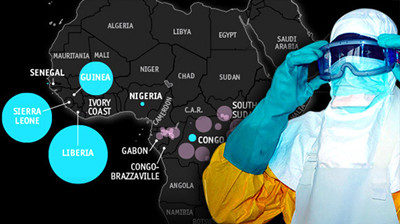(单词翻译:单击)
中英文本
A killer in close up
杀手在敲门
You can do a lot of damage with just seven genes
七个基因,祸害无穷
EBOLA is a simple virus, but also a subtle one. The stringy looking particles consist of a genome wrapped up in two layers of protein. This long, thin package, along with a large protein called a polymerase, is packed into a membrane that is studded with a glycoproteins—that is, proteins with sugar stuck to them.
埃博拉病毒看似简单,实则精妙。由两层蛋白质包裹着由基因组组成的丝状体,形成长而薄的包膜,包膜上布满醣蛋白颗粒,所谓醣蛋白就是糖分子附着在蛋白质上。
When the virus infects a cell the polymerase makes copies of the genome and the cell is tricked into using these to make the proteins that the virus needs. These include two, called VP35 and VP24, which stymie interferons, a class of molecule that alerts the immune system to infection. VP35 prevents interferons from being made; VP24 stops their cries for help from being heard. The sugars on the virus's outside make it hard for other parts of the immune system to get to grips with; to confuse things more, the virus makes infected cells produce more glycoprotein than it needs for its coat, with the surplus simply secreted into the bloodstream. Antibodies which would otherwise attack the virus stick to this decoy protein instead.
当埃博拉病毒感染细胞时,病毒的聚合酶就复制基因组,并诱使细胞使用这些基因组制造病毒所需要的蛋白质。这种蛋白质有两种类型,分别叫做VP35和VP24,它们阻碍干扰素发挥作用,干扰素是一类能向免疫系统发出警示作用的细胞因子。VP35阻止细胞干扰素形成,VP24则阻碍免疫系统接受干扰素的警示信息。病毒外附着的糖分子阻止免疫系统的其他部分捕获该病毒;更麻烦的是,病毒使得被感染的细胞生成超过其表皮需要量的醣蛋白,于是,这些过剩的醣蛋白直接代谢入血液。于是,抗体只能附着在这些作为诱饵的醣蛋白上面,而不会攻击病毒。

Immune cells which the virus attacks in the bloodstream early on carry the infection to the liver, the spleen and lymph nodes. Symptoms may manifest themselves in a day or two or may wait weeks (see chart). Eventually the virus's spread triggers an immune overreaction known as a cytokine storm. Blood-vessel walls become leaky, blood pressure and core temperature drop, organs fail and the body goes into shock. Various combinations of those and other symptoms kill about 70% of those who get ill.
血液中先前被病毒攻击的免疫细胞携带感染元进入肝脏、脾脏和淋巴结。症状可能会在1天、2天或者等上1周后显示出来。最后,病毒的传播引发了免疫过载,这称为“细胞素风暴”。于是,血管壁开始渗漏,血压和体核温度下降,导致器官衰竭,身体休克。这些作用结合其它症状使得70%的患者死亡。
Some of the sick weather the storm, but most who survive infection do so by never getting to its direst straits. Some do not succumb at all: a study of people who had direct contact with patients during outbreaks in Gabon in 1996 showed that some had definitely been infected, but never fallen ill.
一些病人能挨过细胞素风暴,但是能在感染后活下来的人大多数靠的是没有遇到杀招,但有一类人根本就是命硬:一项针对1996年在加蓬爆发期间和病人直接接触的人群的研究表明:一些人绝对受到了感染,但从没有生病。翻译:沈竹 校对:徐牧之
译文属译生译世
词语解释
1.close up 关闭;愈合;靠近
Do not close up your heart.
不要把你的心关起。
Or will you close up like a shell and torture your partner with inconsolable silence?
或者你会像个贝壳那样关闭自己用极度沮丧的沉默折磨你的情人?
2.wrap up 包裹;圆满完成
Use a cloth to wrap up the wound.
用布把伤口包起来。
You should wrap up your neck in this cold weather.
在这样的冷天里,你应把脖子围起来。
3.pack into 挤进…里;塞进
According to the conventional view, liquid water has a similar, albeitless rigid, structure, in which extra molecules can pack into some ofthe open gaps in the tetrahedral arrangement.
根据传统观点,液态的水分子也是类似排列,尽管不那么严格,额外的分子会被包进四面体孔隙里。
PolyPlus's battery may be just that: Dip the encapsulated lithium pack into a glass of ordinary water and it produces current that lights up an LED display at the company's conference showcase booth.
而 PolyPlus 电池也许就是这样一种新技术:把密封包装好的锂浸入一罐普通的水中就能产生电流,可将公司展会展位上的LED灯点亮。
4.immune system 免疫系统
The immune system then kicks in, and the body and the virus wage all-out war.
此后,免疫系统开始发挥作用,身体与病毒之间的战争由此全面爆发。
Aids, he said, was brought about by the collapse of the immune system-but not because of a virus.
他说,艾滋病是免疫系统的崩溃所带来的,而不是一位某种病毒带来的。


